微观经济学作业3
微观经济学作业第三部分

微观经济学作业第三部分:第六章、第七章:生产和成本理论一、名词及专业术语解释:生产函数、边际产量、边际收益递减规律、等产量曲线、生产要素的边际技术替换率及其递减规律、生产的规模收益性(规模报酬递增、规模报酬不变和规模报酬递减)、固定成本、可变成本、边际成本、长期成本、规模经济性和规模不经济性二、选择题(从四个备选答案中选出一个最佳答案)33.一种可变投入的平均产量由下列哪一项中的比率决定?a.总产量的变化与总产量之比。
b.一种投入单位数的变化与所有投入单位数的变化之比。
c.所有投入的总单位数与一种投入的总单位数之比。
d.总产量与一种可变投入的总单位数之比。
34.边际收益递减规律指的是:a.任何一种投入的总产量最终一定会达到最大,且随着该投入单位数的增加而减少。
b.任何一种投入的平均产量最终一定会达到最小,且随着所有投入的增加而成比例地增加。
c.任何一种投入的边际产量最终都会随着该投入单位数的增加而减少。
d.任何一种投入的平均产量都会随着该投入单位数的增加而先增加后减少。
35.如果一种投入的边际产量为正,但它随着投入数量的增加而递减,那么:a.总产量达到了最大并开始下降。
b.总产量会增加,但增加的速度越来越慢。
c.平均产量一定正在下降。
d.企业应该减少生产。
36.如果某种投入的平均产量高于它的边际产量,那么:a.边际产量一定随着该投入的增加而增加。
b.平均产量一定随着该投入的增加而增加。
c.平均产量一定随着该投入的增加而下降。
d.总产量一定随着该投入的增加而下降。
37.长期生产是指:a.企业生产时期的时间较长。
b.企业不断的再生产。
c.企业生产期中所有的投入都是可变的。
d.企业生产期中所有的投入都是固定的。
38.生产函数是指:a.对应于一定数量的投入,至少能生产多少产品。
b.对应于一定数量的投入,实际的产出数量。
c.在既定技术条件下,对应于一定的投入要素,最大效率的产出数量。
d.在既定技术条件下,对应于一定的投入要素,合理的产出数量。
最新《微观经济学(高起专)》习题三答案
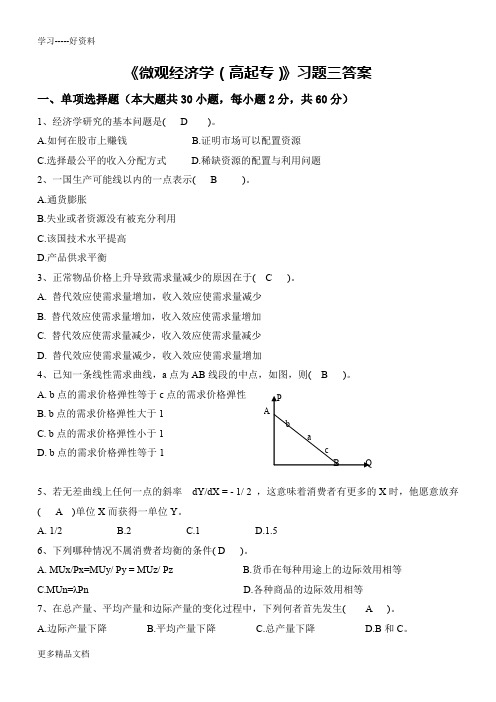
《微观经济学(高起专)》习题三答案一、单项选择题(本大题共30小题,每小题2分,共60分)1、经济学研究的基本问题是( D )。
A.如何在股市上赚钱B.证明市场可以配置资源C.选择最公平的收入分配方式D.稀缺资源的配置与利用问题2、一国生产可能线以内的一点表示( B )。
A.通货膨胀B.失业或者资源没有被充分利用C.该国技术水平提高D.产品供求平衡 3、正常物品价格上升导致需求量减少的原因在于( C )。
A. 替代效应使需求量增加,收入效应使需求量减少B. 替代效应使需求量增加,收入效应使需求量增加C. 替代效应使需求量减少,收入效应使需求量减少D. 替代效应使需求量减少,收入效应使需求量增加4、已知一条线性需求曲线,a 点为AB 线段的中点,如图,则( B )。
A. b 点的需求价格弹性等于c 点的需求价格弹性B. b 点的需求价格弹性大于1C. b 点的需求价格弹性小于1D. b 点的需求价格弹性等于15、若无差曲线上任何一点的斜率 dY/dX = - 1/ 2 ,这意味着消费者有更多的X 时,他愿意放弃( A )单位X 而获得一单位Y 。
A. 1/2B.2C.1D.1.56、下列哪种情况不属消费者均衡的条件( D )。
A. MUx/Px=MUy/ Py = MUz/ PzB.货币在每种用途上的边际效用相等C.MUn=λPnD.各种商品的边际效用相等7、在总产量、平均产量和边际产量的变化过程中,下列何者首先发生( A )。
A.边际产量下降B.平均产量下降C.总产量下降D.B 和C 。
PA b ac B Q8、从原点出发与TC曲线相切的直线的斜率是( D )。
A.AC的最低点,B.等于MC,C.是A VC与AFC之和,D.以上都成立。
9、假如某厂商的平均收益曲线从水平线变为向右下方倾斜的曲线,这说明( B )。
A.既有厂商进入也有厂商退出该行业;B.完全竞争被不完全竞争所取代;C.新的厂商进入了该行业;D.原有厂商退出了该行业10、在完全竞争市场中行业的长期供给曲线取决于( D )。
东财14秋《微观经济学》在线作业三答案

微观经济学东财《微观经济学》在线作业三一,单选题1. 完全垄断者根据消费者购买商品数量的不同制定不同的价格的价格歧视是()A. 一级价格歧视B. 二级价格歧视C. 三级价格歧视D. 以上都不对?正确答案:B2. 如果某企业的收益不足以弥补可变成本,为了把损失减少到最低程度,他应该()A. 减少产量B. 增加产量C. 停产D. 降价促销?正确答案:C3. 经济学是关于个人和国家如何:()A. 用有限的资源满足无限的需要B. 用无限的资源满足有限的需要C. 用无限的资源满足无限的需要D. 用有限的资源满足有限的需要?正确答案:A4. 以下哪一项是宏观经济学的研究的问题?()A. 失业率和通货膨胀率的关系B. 美国烟草歉收对世界烟草价格的影响C. 最低工资对青年工人失业的影响D. “积极行动”项目对教师工资率的影响?正确答案:A5. 现有资源不能满足人的欲望这一事实被称为()A. 机会成本B. 稀缺性C. 经济学D. 生产什么的问题?正确答案:B6. 13.如果某种产品的生产正在造成污染,因而社会边际成本大于私人边际成本,适当的税收政策是征税,征税额等于()A. 社会边际成本和私人边际成本之差B. 私人边际成本C. 治理污染设备的成本D. 社会边际成本?正确答案:A7. 决定要素需求的因素有()A. 对产品的需求B. 生产技术C. 要素价格D. 以上都对?正确答案:D8. 下列条件中与完全竞争市场中短期均衡条件不相符的是()A. P=MPB. MC=MRC. P=MCD. MC=AR?正确答案:A9. 哪一项正确地描述了价格调节如何消除短缺()A. 随着价格上升,需求量减少而供给量增加B. 随着价格上升,需求量增加而供给量减少C. 随着价格下降,需求量减少而供给量增加D. 随着价格下降,需求量增加而供给量减少?正确答案:A10. 竞争企业的短期供给曲线是()A. 平均可变成本曲线在边际成本曲线以上的那一部分B. 平均总成本曲线在边际成本曲线以上的那一部分C. 边际成本曲线在平均可变成本曲线以上的那一部分D. 边际成本曲线在平均总成本曲线以上的那一部分?正确答案:C11. 11.市场中单个企业对某种要素的需求曲线同全体企业对该种要素需求曲线之间的关系变现为()A. 二者是重合一起的B. 前者较后者平坦C. 前者较后者陡峭D. 无法确定?正确答案:B12. 需求可分为个人需求和()A. 个人价格B. 市场需求C. 市场价格D. 均衡需求?正确答案:B13. 13.()不是帕累托最优的必要条件。
微观经济学练习题(三)
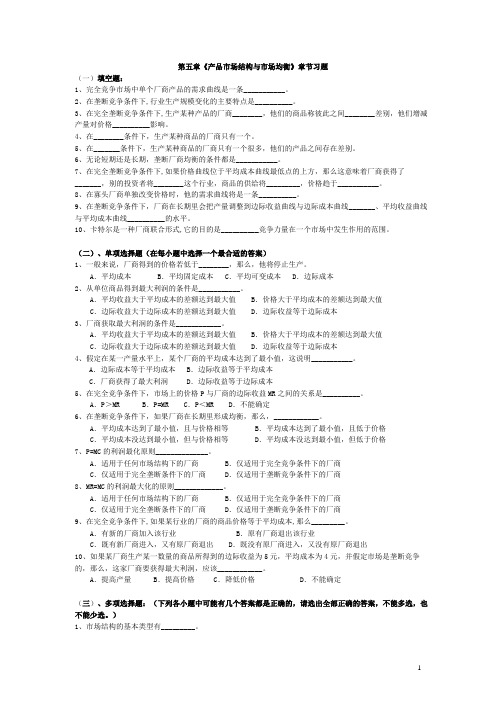
第五章《产品市场结构与市场均衡》章节习题(一)填空题:1、完全竞争市场中单个厂商产品的需求曲线是一条___________。
2、在垄断竞争条件下,行业生产规模变化的主要特点是__________。
3、在完全垄断竞争条件下,生产某种产品的厂商________,他们的商品称彼此之间________差别,他们增减产量对价格__________影响。
4、在________条件下,生产某种商品的厂商只有一个。
5、在_______条件下,生产某种商品的厂商只有一个很多,他们的产品之间存在差别。
6、无论短期还是长期,垄断厂商均衡的条件都是___________。
7、在完全垄断竞争条件下,如果价格曲线位于平均成本曲线最低点的上方,那么这意味着厂商获得了_______,别的投资者将________这个行业,商品的供给将_________,价格趋于___________。
8、在寡头厂商单独改变价格时,他的需求曲线将是一条__________。
9、在垄断竞争条件下,厂商在长期里会把产量调整到边际收益曲线与边际成本曲线_______、平均收益曲线与平均成本曲线__________的水平。
10、卡特尔是一种厂商联合形式,它的目的是__________竞争力量在一个市场中发生作用的范围。
(二)、单项选择题(在每小题中选择一个最合适的答案)1、一般来说,厂商得到的价格若低于________,那么,他将停止生产。
A.平均成本 B.平均固定成本 C.平均可变成本 D.边际成本2、从单位商品得到最大利润的条件是___________。
A.平均收益大于平均成本的差额达到最大值 B.价格大于平均成本的差额达到最大值C.边际收益大于边际成本的差额达到最大值 D.边际收益等于边际成本3、厂商获取最大利润的条件是____________。
A.平均收益大于平均成本的差额达到最大值 B.价格大于平均成本的差额达到最大值C.边际收益大于边际成本的差额达到最大值 D.边际收益等于边际成本4、假定在某一产量水平上,某个厂商的平均成本达到了最小值,这说明___________。
微观经济学3供求理论

需求变动
需求变动:商品价格以外的因素变化引 起的购买数量变化。
当所要购买的数量在每一价格水平增加 时,我们说需求增加。
当所要购买的数量在每一价格水平减少 时,我们说需求减少。
20
收入增加,需求增加
商品价格 0 1 2 3 4 5
最初的需求量 20 16 12 8 4 0
变化后的需求量 30 24 18 12 6 2
45
需求增加如何影响均衡
冰激凌蛋卷价格
1.天气炎热,冰激凌的需求增加, 需求曲线右移
$2.50 2.00
2. 价格上涨
0 3. 销售额增加 7
供给 新的均衡点
初始均衡点
D2
D1
10
冰激凌蛋卷数量
46
例2:地震如何改变冰激凌市场的 均衡?
事件:地震 影响冰激凌市场的供给还是需求? 曲线如何移动?
39
供给与需求的均衡
冰激凌价格
$3.00 2.50 2.00
供给Supply
均衡点 Equilibrium
1.50 1.00 0.50
0 1 2 3 4 5 6 7 8 9 10 11 12
需求Demand
冰激凌数量
40
市场不均衡
超额供给(excess supply):供给量 大于需求量,出现过剩,价格会下 降。
21
需求曲线的移动
在图形上,物品价格以外的因素发生变 化,会引起需求曲线的移动。
需求曲线移动,要么左移,要么右移。 需求增加,需求曲线右移;需求减少,
需求曲线左移。
22
需求的变化
价格
需求增加
需求减少
D2
0
D3
D1
数量
微观经济学习题:3 效用论(刘兰)
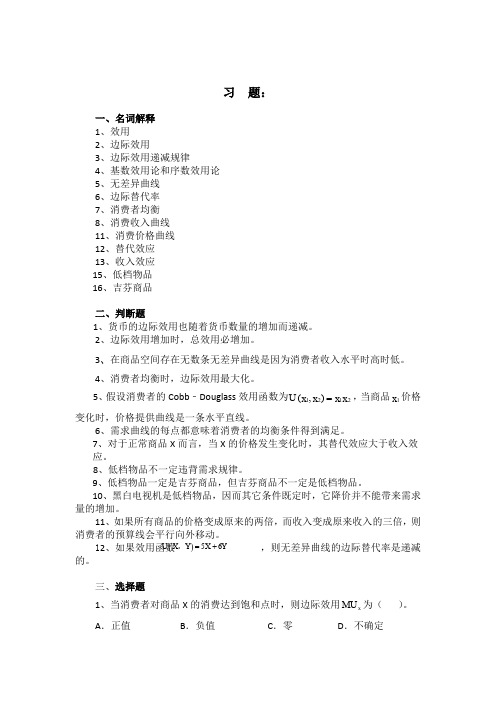
习 题:一、名词解释1、效用2、边际效用3、边际效用递减规律4、基数效用论和序数效用论5、无差异曲线6、边际替代率7、消费者均衡8、消费收入曲线11、消费价格曲线12、替代效应13、收入效应15、低档物品16、吉芬商品二、判断题1、货币的边际效用也随着货币数量的增加而递减。
2、边际效用增加时,总效用必增加。
3、在商品空间存在无数条无差异曲线是因为消费者收入水平时高时低。
4、消费者均衡时,边际效用最大化。
5、假设消费者的Cobb ﹣Douglass 效用函数为1212(,)U x x x x =,当商品1x 价格变化时,价格提供曲线是一条水平直线。
6、需求曲线的每点都意味着消费者的均衡条件得到满足。
7、对于正常商品X 而言,当X 的价格发生变化时,其替代效应大于收入效应。
8、低档物品不一定违背需求规律。
9、低档物品一定是吉芬商品,但吉芬商品不一定是低档物品。
10、黑白电视机是低档物品,因而其它条件既定时,它降价并不能带来需求量的增加。
11、如果所有商品的价格变成原来的两倍,而收入变成原来收入的三倍,则消费者的预算线会平行向外移动。
12、如果效用函数 ,则无差异曲线的边际替代率是递减的。
三、选择题1、当消费者对商品X 的消费达到饱和点时,则边际效用x MU 为( )。
A .正值B .负值C .零D .不确定()56U X Y X Y =+,2、边际效用随消费量的增加而( )。
A .递减B .递增C .按相同方向变动D .保持不变3、当消费达到饱和点时,总效用曲线呈( )。
A .向右上方倾斜B .向右下方倾斜C .水平状D .向左上方弯曲4、基数效用论关于消费者均衡的条件是( )。
A .无差异曲线与预算线相切B ./xy x y MRS P P =C .//x x y y MU P MU P =D .//x y y x MU MU P P =5、设对某一消费者有//x x y y MU P MU P <,为使他得到的效用最大,他将( )。
微观经济学练习题及答案 (3)
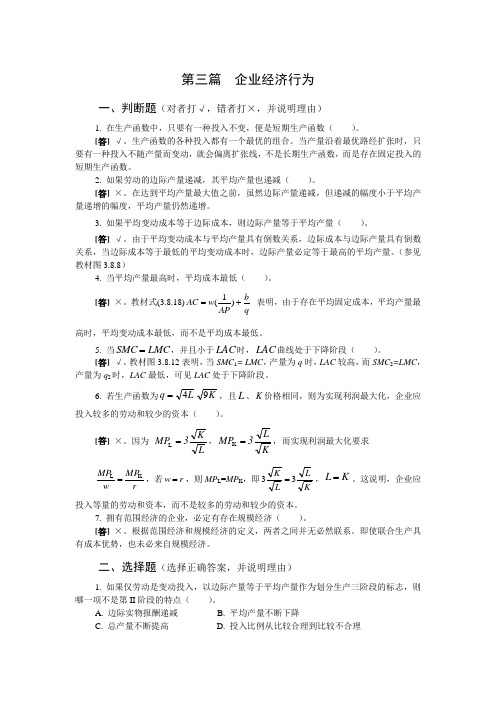
年利率 5%;生产工人工资总额 120 万元;管理人员工资总额 10 万元;原料、材料、动力
费用 1 500 万元。则其总固定成本为( )。
A. 60 万元
B. 65 万元
C. 75 万元 D. 1 000 万元
E.
1 100 万元
[答] C。由于固定资产并非一次消耗,长期贷款利息短期不变,管理人员相对稳定,企
业每年的固定投入是折旧费、利息和管理人员工资,总计 75 万元。
5. 若某个产量的长期平均成本等于短期平均成本,但高于长期边际成本,则可推断
( )。
A. 规模报酬处于递减阶段
B. 长期平均成本正在下降
C. 短期平均成本最小
D. 短期平均成本等于长期边际成本
E. 短期边际成本等于长期边际成本
F. 仅 B,E 正确
6. 某运输公司现有小轿车 100 辆,大轿车 15 辆。根据市场分析,在目前的情况下,如 果再增加 1 辆小轿车,可以增加每月营业收入 10 000 元;如果增加 1 辆大轿车,每月可以 增加营业收入 30 000 元。估计增加 1 辆小轿车或大轿车每月的费用分别是 1 250 元和 2 500 元。问:目前该企业的车辆结构是不是合理?如果不合理,应如何改进?
2 199 282 345 399 446 488 528 564
1 141 199 244 282 315 345 373 399
0
1
2
3
4
5
6
7
8L
(1)估计带数值系数的生产函数。 (2)绘出一条包括 4 个投入组合的等产量线,并计算各组合处劳动对资本的边际技术 替代率。 (3)这个生产函数处于何种规模报酬阶段? (4)当总产量为 423 时,求劳动和资本的平均产量、边际产量、产出弹性和生产力弹 性。 (5)当劳动价格为 20、资本价格为 30 时,达到总产量 345 的最低总成本是多少? [答](1)运用两个变动投入生产函数的有关知识,仔细琢磨坐标数值,不难发现有以 下两个特征: ① 劳动与资本可以完全替代。设 q f (L, K) ,则 f (L, K) f (K, L) 。
宏微观经济学第三次作业题及答案.doc

二、问答题(本大题共40分,共10小题,每小题4分)
1.经济理论要研究解决的是哪五个基本问题?
2.为什么短期平均成本曲线是U型的?
dX
1000=10X
X=100
(2)每户分摊的总成本为
总成本,却可以在整个牧场放牧一将整个牧场最佳放牧头数作为自己的放牧头数。这必定使牧场载畜量过大,逐步荒芜,导致“公地悲剧”O
解题方案:评分标准:
二、问答题(40分,共10题,每小题4分)
1.
参考答案:
生产什么,怎么生产,为谁生产,何时生产,谁做决策(即五个W)O
304553586265687072
8.请按下表如实填写新学期第一月你的实际消费金额(元)和比例,计算恩格尔系数,并分析一年来消费构成的变化及其原因。项目食品衣着书报文具娱乐其他合计主食副食饮料外买小计金额%
9.企业利润最大化和要素投入的最优组合之间是什么关系?
10.为什么完全竞争的市场机制符合帕累托最优状态?
3.简述科斯定理对解决外部经济影响的意义和存在的问题。
4.简述产品转换曲线的含义及特征。
5.在生产的三个阶段中,问:(1)为什么厂商的理性决策应在第二阶段?
(2)厂商将使用什么样的要素组合?(3)如果PL=0或PK=O,或PL=PK,厂商应在何处生产?
6.如果没有工资刚性的假设,凯恩斯扩张总需求的政策效应将如何?
利阁71 = TR -TC = P^q—\ q:—llcf+40g I ,将P =100q =10代入上式得= 800叫即厂商实现MR=LMC时的产里、平均成本和利底]分别为10s20和800o〃
《微观经济学》课后练习题3-1910
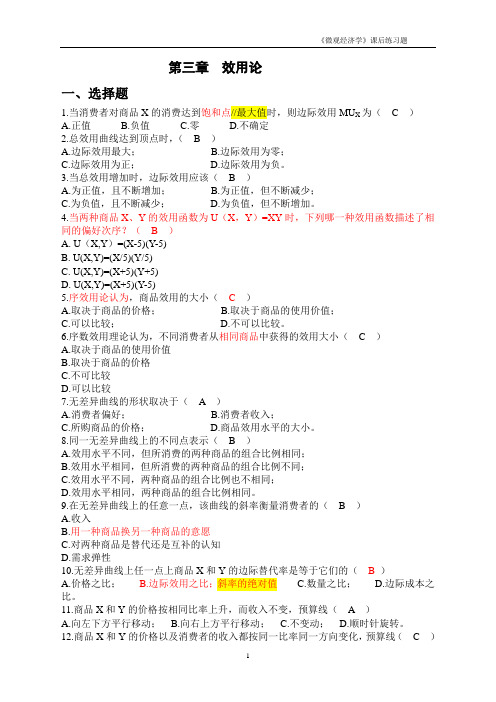
第三章效用论一、选择题1.当消费者对商品X的消费达到饱和点//最大值时,则边际效用MU X为( C )A.正值B.负值C.零D.不确定2.总效用曲线达到顶点时,( B )A.边际效用最大;B.边际效用为零;C.边际效用为正;D.边际效用为负。
3.当总效用增加时,边际效用应该( B )A.为正值,且不断增加;B.为正值,但不断减少;C.为负值,且不断减少;D.为负值,但不断增加。
4.当两种商品X、Y的效用函数为U(X,Y)=XY时,下列哪一种效用函数描述了相同的偏好次序?( B )A. U(X,Y)=(X-5)(Y-5)B. U(X,Y)=(X/5)(Y/5)C. U(X,Y)=(X+5)(Y+5)D. U(X,Y)=(X+5)(Y-5)5.序效用论认为,商品效用的大小( C )A.取决于商品的价格;B.取决于商品的使用价值;C.可以比较;D.不可以比较。
6.序数效用理论认为,不同消费者从相同商品中获得的效用大小( C )A.取决于商品的使用价值B.取决于商品的价格C.不可比较D.可以比较7.无差异曲线的形状取决于( A )A.消费者偏好;B.消费者收入;C.所购商品的价格;D.商品效用水平的大小。
8.同一无差异曲线上的不同点表示( B )A.效用水平不同,但所消费的两种商品的组合比例相同;B.效用水平相同,但所消费的两种商品的组合比例不同;C.效用水平不同,两种商品的组合比例也不相同;D.效用水平相同,两种商品的组合比例相同。
9.在无差异曲线上的任意一点,该曲线的斜率衡量消费者的( B )A.收入B.用一种商品换另一种商品的意愿C.对两种商品是替代还是互补的认知D.需求弹性10.无差异曲线上任一点上商品X和Y的边际替代率是等于它们的(B)A.价格之比;B.边际效用之比;斜率的绝对值C.数量之比;D.边际成本之比。
11.商品X和Y的价格按相同比率上升,而收入不变,预算线( A )A.向左下方平行移动;B.向右上方平行移动;C.不变动;D.顺时针旋转。
《微观经济学(高起专)》习题三答案

《微观经济学(高起专)》习题三答案一、单项选择题(本大题共30小题,每小题2分,共60分)1、经济学研究的基本问题是( D )。
A.如何在股市上赚钱B.证明市场可以配置资源C.选择最公平的收入分配方式D.稀缺资源的配置与利用问题2、一国生产可能线以内的一点表示( B )。
A.通货膨胀B.失业或者资源没有被充分利用C.该国技术水平提高D.产品供求平衡 3、正常物品价格上升导致需求量减少的原因在于( C )。
A. 替代效应使需求量增加,收入效应使需求量减少B. 替代效应使需求量增加,收入效应使需求量增加C. 替代效应使需求量减少,收入效应使需求量减少D. 替代效应使需求量减少,收入效应使需求量增加4、已知一条线性需求曲线,a 点为AB 线段的中点,如图,则( B )。
A. b 点的需求价格弹性等于c 点的需求价格弹性B. b 点的需求价格弹性大于1C. b 点的需求价格弹性小于1D. b 点的需求价格弹性等于15、若无差曲线上任何一点的斜率 dY/dX = - 1/ 2 ,这意味着消费者有更多的X 时,他愿意放弃( A )单位X 而获得一单位Y 。
A. 1/2B.2C.1D.1.56、下列哪种情况不属消费者均衡的条件( D )。
A. MUx/Px=MUy/ Py = MUz/ PzB.货币在每种用途上的边际效用相等C.MUn=λPnD.各种商品的边际效用相等7、在总产量、平均产量和边际产量的变化过程中,下列何者首先发生( A )。
A.边际产量下降B.平均产量下降C.总产量下降D.B 和C 。
8、从原点出发与TC 曲线相切的直线的斜率是( D )。
PA b ac B QA.AC的最低点,B.等于MC,C.是A VC与AFC之和,D.以上都成立。
9、假如某厂商的平均收益曲线从水平线变为向右下方倾斜的曲线,这说明( B )。
A.既有厂商进入也有厂商退出该行业;B.完全竞争被不完全竞争所取代;C.新的厂商进入了该行业;D.原有厂商退出了该行业10、在完全竞争市场中行业的长期供给曲线取决于( D )。
微观经济学第3章部分练习题答案

微观经济学第3章部分练习题答案《微观经济学》第三章练习题参考答案1、已知⼀件衬衫的价格为80元,⼀份肯德鸡快餐的价格为20元,在某消费者关于这两种商品的效⽤最⼤化的均衡点上,⼀份肯德鸡快餐对衬衫的边际替代率MRS 是多少?解:按照两商品的边际替代率MRS 的定义公式,可以将⼀份肯德鸡快餐对衬衫的边际替代率写成: XY MRS XY ??-=其中:X 表⽰肯德鸡快餐的份数;Y 表⽰衬衫的件数; MRS 表⽰在维持效⽤⽔平不变的前提下, 消费者增加⼀份肯德鸡快餐时所需要放弃的衬衫消费数量。
在该消费者实现关于这两件商品的效⽤最⼤化时,在均衡点上有MRS xy =P x /P y 即有MRS xy =20/80=它表明:在效⽤最⼤化的均衡点上,消费者关于⼀份肯德鸡快餐对衬衫的边际替代率MRS 为。
2 假设某消费者的均衡如图1-9所⽰。
其中,横轴1OX 和纵轴2OX ,分别表⽰商品1和商品2的数量,线段AB 为消费者的预算线,曲线U 为消费者的⽆差异曲线,E 点为效⽤最⼤化的均衡点。
已知商品1的价格P 1=2元。
(2)求上品的价格P;2(3)写出预算线的⽅程;(4)求预算线的斜率;(5)求E点的MRS的值。
12解:(1)图中的横截距表⽰消费者的收⼊全部购买商品1的数量为30单位,且已知P1=2元,所以,消费者的收⼊M=2元×30=60。
(2)图中的纵截距表⽰消费者的收⼊全部购买商品2的数量为20单位,且由(1)已知收⼊M=60元,所以,商品2的价格P2斜率=-P1/P2=-2/3,得P2=M/20=3元(3)由于预算线的⼀般形式为:P1X1+P2X2=M所以,由(1)、(2)可将预算线⽅程具体写为2X1+3X2=60。
(4)将(3)中的预算线⽅程进⼀步整理为X2=-2/3 X1+20。
很清楚,预算线的斜率为-2/3。
(5)在消费者效⽤最⼤化的均衡点E上,有MRS12= = MRS12=P1/P2,即⽆差异曲线的斜率的绝对值即MRS等于预算线的斜率绝对值P1/P2。
微观经济学第三章练习+答案

第三章练习一、单项选择题1.设劳动是唯一可变要素,当总产量下降时,( )A. 劳动的平均产量等于零B. 劳动的边际产量等于零C. 劳动的平均产量小于零D. 劳动的平均产量下降2.当劳动的平均产量大于零时,边际产量是( )A. 下降的B. 0C. 负的D. 以上都可能3.当边际产量小于零时,要素的投入阶段是()A. 阶段ⅠB. 阶段ⅡC. 阶段ⅢD. 以上都不对4.当AP L为正且递减时,MP L可以()A. 递增且为正;B. 递减且为负;C. 递减且为正;D. 上述三个选项中只有A不可能。
5.以下各项中可能是短期成本函数的是()A.TC=0.6Q3-10Q2+300QB. TC=2Q3-10Q2+300Q+100C. TC=10Q2-3Q3+300Q+100D. TC=10Q2-3Q3+300Q6.等产量线特性()A. 一般斜率为负B. 凹向原点C.不同的等产量线只有一个交点D. 以上说法都对7.设横轴为劳动L,纵轴为资本K,P L、P K是劳动和资本的价格,则等成本线的斜率为()A. P L/P KB. P K/P LC. -P L/P KD. -P K/P L8.下列说法中错误的是()A.只要总产量减少,边际产量一定为负数;B.只要边际产量减少,总产量一定减少;C.边际产量曲线在平均产量曲线的最高点与之相交;D.只要平均产量增加,边际产量就大于平均产量;9.理性的短期生产者选择的生产区域应是()A. MP>AP阶段B. MP下降阶段C. AP下降阶段D. MP与AP相交之点起至MP与横轴交点止10.下列说法中正确的是()A.总产量TP开始下降时,边际产量MP也开始下降B.只要边际产量MP下降,总产量TP一定下降C.边际产量MP曲线必定交于平均产量AP曲线的最高点D.只要边际产量MP下降,平均产量AP 也一定下降11.生产者均衡时()A. MP L/MP K=P K/P LB. MRTS LK=MP K/MP LC. MRTS KL=MPK/MPLD. 以上都不对12.L型的等产量曲线,表示两要素的边际替代率()A.无穷大B. 保持不变C. 为零D. 以上都有可能13.规模报酬考查的是()生产A. 短期B. 长期C.短期和长期都可以D. 以上都不对14.边际收益递减规律的适用条件是()A. 生产技术没有发生重大变化B. 不考虑技术是否变化C. 所有要素投入同时改变D. 以上三条都不适用15.与生产理论中的扩展线相类似的,是消费者理论中的( )A. 价格—消费曲线B. 恩格尔曲线C. 收入—消费曲线D. 预算约束线16.边际收益(边际生产力、边际产量)递减规律所研究的问题是()A. 各种生产要素同时变动对产量的影响B. 其他生产要素不变,一种生产要素变动对产量的影响C. 一种生产要素不变,其他几种生产要素变动对产量的影响D. 两种生产要素同时以相同比例变动时对产量的影响17.规模报酬递减是在下述情况下发生的:( )A. 按比例连续增加各种生产要素B. 不按比例连续增加各种生产要素C. 连续地投入某种生产要素而保持其他生产素不变D. 上述都正确18.在生产者均衡点上有()A.MRTS LK=P L/P KB.MP L/P L=MP K/P KC.等产量曲线与等成本线相切D.上述都正确19.如果等成本曲线与等产量曲线没有交点,则要生产等产量曲线所表示的产量,应该()A.增加投入B.保持原投入不变C.减少投入D.上述三者都不正确。
2024年春江苏开放大学宏微观经济学计分作业3市场调研

2024年春江苏开放大学宏微观经济学计分作业3模拟实训:市场调研实践目标:1. 检验学生对公共福利的认识程度;2. 考察学生对经济调研分析方法的运用能力。
实践内容:1. 调研你所在城市或省份政府部门所提供的公共福利现状2. 撰写分析报告。
实践操作:1.对你的所在城市政府所实施的公共福利进行文件查阅分析,如政府官网、政府文件等;2.设计简单的问卷在朋友圈广泛收集人们所感受到自己享受到的公共福利都有哪些?希望政府提供其他哪些方面的公共福利;3. 调查内容主要包括:(1)目前政府所实施的公共福利明细项目(要分类概括出来,如教育类的、医疗类的、养老类的……等);(2)目前政府没有实施的公共福利但老百姓希望实施的有哪些(概括罗列出来)实验报告:1. 结合所掌握的调查资料和信息,撰写一篇1000字的调研报告建议题目:某某城市公共福利现状调查及改善对策调研分析2.要求在下载的文档中完成后提交,按照要求排版3.在规定的时间内完成,迟交将适当扣分4.禁止抄袭,违反以零分处理答案:苏州市公共福利现状调查及改善对策调研分析一、引言公共福利作为政府为公民提供的基本生活保障和优质服务,对于提升居民生活质量、促进社会和谐稳定具有重要意义。
本报告通过对苏州市政府所实施的公共福利进行文件查阅分析,并结合朋友圈问卷调查,旨在全面了解苏州市公共福利的现状及市民的需求,为政府制定更为精准的福利政策提供参考。
二、苏州市公共福利现状(一)教育类福利苏州市政府高度重视教育事业发展,投入大量资金用于改善教育条件和提高教育质量。
目前,苏州市已实施多项教育类福利政策,包括义务教育阶段的免费教育、家庭经济困难学生的资助政策、教师队伍建设等。
此外,政府还积极推动教育信息化建设,提升教育现代化水平。
(二)医疗类福利在医疗领域,苏州市政府不断完善医疗保障体系,提高医疗保障水平。
目前,苏州市已建立覆盖城乡的医疗保险制度,为居民提供基本医疗保障。
同时,政府还加大了对基层医疗机构的投入,提升基层医疗服务能力,方便居民就医。
《微观经济学》第3章效用论练习题及答案解析

第三章效用论一、选择题1.假如某消费者所消费的几种商品的价格都相同,为了使其在消费的过程中获得最大的满足,该消费者应该购买()。
A.相同数量的这几种商品 B.这几种商品并使其总效用相等C.这几种商品并使其边际效用相等 D.以上答案都不对解析:C.本题考察效用最大化均衡条件当P X=P Y= P n,要满足效用最大化均衡条件必须使MU X=MU Y=MU n.2.假设货币的边际效用为1,消费者购买每一单位物品所支付的价格一定等于()。
A.消费者从消费第一单位的这种物品中获取的边际效用B.消费者从消费这种物品中获取的总效用C.消费者从平均每单位物品的消费中获取的效用D.消费者从消费最后一单位物品中获取的边际效用解析:D.本题考察效用最大化均衡条件当λ=1,要满足效用最大化均衡条件必须使,即MU X=P X MU Y=P Y MU N=P N3.就一个消费者对某种商品的需求曲线来看,该需求曲线上与每一个价格水平相对应的需求量()。
A.均是能给这个消费者带来最大效用的均衡数量B.并不是能给这个消费者带来最大效用的均衡数量C.有可能是能给这个消费者带来最大效用的均衡数量D.是这个消费者边际效用达到最大的需求数量解析:A.本题考察效用论如何推导出需求曲线,当消费者只购买一种商品时,满足效用最大化均衡条件,货币的边际效用λ可以假设不变,随着消费者消费的商品数量越来越多,商品带给消费者的边际效用递减,消费者愿意出的价钱也递减。
表现为需求曲线向右下方倾斜。
需求曲线上的每一个价格下消费者对应的消费数量都满足均衡条件,令消费者获得最大效用。
4.一个消费者愿意为第一杯啤酒支付11元,为第二杯支付7元,为第三杯支付4元,为第四杯支付2元,为第五杯支付1元。
如果每杯啤酒的价格为2元,则此消费者效用最大时消费者剩余是()元。
A.25 B.23 C.16 D.15解析:C.本题同时考察效用最大化均衡条件和消费者剩余计算方法。
当消费者只购买一种商品时,满足效用最大化均衡条件,第四杯啤酒带给消费者和2元钱相同的效用,正好市场价格是2元钱,此时总效用最大。
《微观经济学》第3次作业
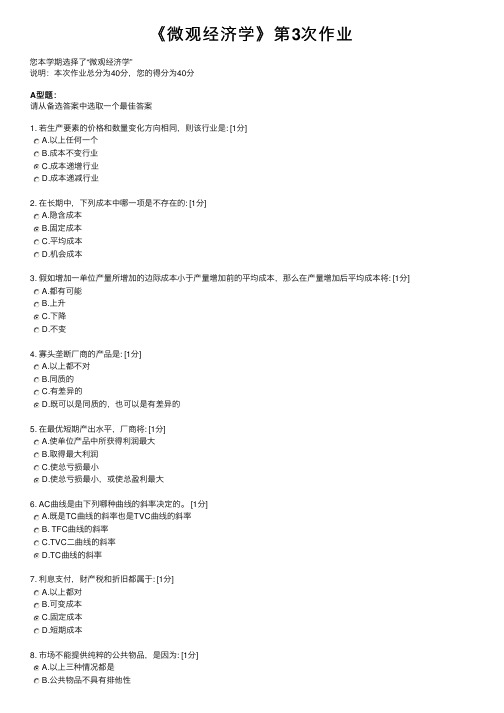
《微观经济学》第3次作业您本学期选择了“微观经济学”说明:本次作业总分为40分,您的得分为40分A型题:请从备选答案中选取⼀个最佳答案1. 若⽣产要素的价格和数量变化⽅向相同,则该⾏业是: [1分]A.以上任何⼀个B.成本不变⾏业C.成本递增⾏业D.成本递减⾏业2. 在长期中,下列成本中哪⼀项是不存在的: [1分]A.隐含成本B.固定成本C.平均成本D.机会成本3. 假如增加⼀单位产量所增加的边际成本⼩于产量增加前的平均成本,那么在产量增加后平均成本将: [1分]A.都有可能B.上升C.下降D.不变4. 寡头垄断⼚商的产品是: [1分]A.以上都不对B.同质的C.有差异的D.既可以是同质的,也可以是有差异的5. 在最优短期产出⽔平,⼚商将: [1分]A.使单位产品中所获得利润最⼤B.取得最⼤利润C.使总亏损最⼩D.使总亏损最⼩,或使总盈利最⼤6. AC曲线是由下列哪种曲线的斜率决定的。
[1分]A.既是TC曲线的斜率也是TVC曲线的斜率B. TFC曲线的斜率C⼆曲线的斜率D.TC曲线的斜率7. 利息⽀付,财产税和折旧都属于: [1分]A.以上都对B.可变成本C.固定成本D.短期成本8. 市场不能提供纯粹的公共物品,是因为: [1分]A.以上三种情况都是B.公共物品不具有排他性C.公共物品不具有竞争性D.消费者都想“免费搭车”9. 随着产量的增加,平均固定成本: [1分]A.⼀直趋于下降B.在开始时下降,然后趋于上升C.在开始时上升,然后趋于下降D.⼀直趋于上升10. 为了提⾼资源配置效率,政府对竞争性⾏业⼚商的垄断⾏为是: [1分]A.放任不管的限制的C.⽀持的D.有条件加以限制的11. 假设⽣产某种产品需要使⽤A、B、C三种⽣产要素,当A的投⼊量连续增加时,它的边际产品: [1分]A.以上均不正确B.在技术条件及B和C投⼊量不变时下降C.在技术条件不变,但B和C的数量同⽐例增长加时下降D.在任何条件下都下降12. 卡特尔制定统⼀价格的原则是: [1分]A.使整个卡特尔中各⼚商的利润最⼤B.使整个卡特尔的产量最⼤使整个卡特尔的利润最⼤D.使整个卡特尔的成本最⼩13. 消费者均衡的条件是: [1分]A.以上三者都不是B.C.D.P X·X=P Y·Y14. 古诺双头垄断⼚商的反应函数给出了: [1分]A.在另⼀个⼚商价格给定条件下⼀个⼚商的价格⽔平B.在另⼀个⼚商产量给定条件下⼀个⼚商的产量⽔平C.在另⼀个⼚商产量给定条件下⼀个⼚商的价格⽔平D.在另⼀个⼚商价格给定条件下⼀个⼚商的产量⽔平15. 边际转换率是下列哪⼀条曲线的斜率? [1分]A.⽣产可能性曲线B.需求曲线C.契约曲线D.边际产品曲线16. 垄断竞争⼚商长期均衡时,必然有: [1分]A.边际成本等于实际需求曲线中产⽣的边际收益B.价格⼤于长期平均成本C.在均衡点上,“想象”的需求曲线上的弹性⼤于“市场份额”需求曲线上的弹性D.资源在⼴告中浪费17. 假如某⼚商的平均收益曲线从⽔平线变为向右下⽅倾斜的曲线,这说明: [1分]A.原有⼚商退出了该⾏业B.既有⼚商进⼊也在⼚商退出该⾏业C.完全竞争被不完全竞争所取代D.新的⼚商进⼊了该⾏业18. 当正外部性发⽣在⼀种产品的⽣产中时: [1分]A.社会边际收益等于私⼈边际收益。
《微观经济学》课后练习题3-1110
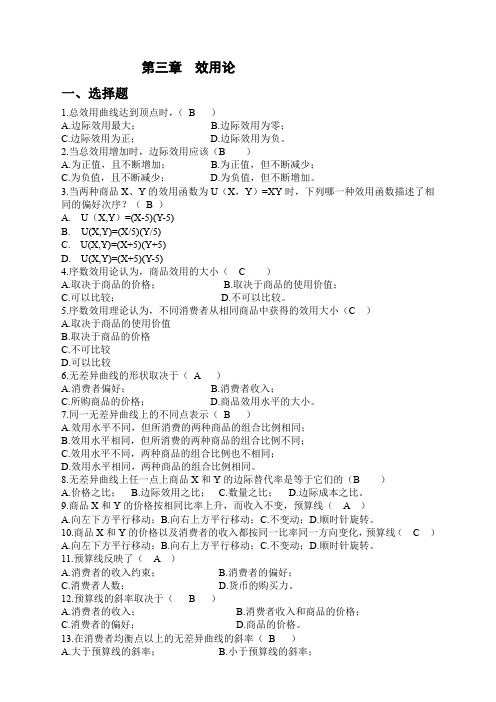
第三章效用论一、选择题1.总效用曲线达到顶点时,(B )A.边际效用最大;B.边际效用为零;C.边际效用为正;D.边际效用为负。
2.当总效用增加时,边际效用应该(B )A.为正值,且不断增加;B.为正值,但不断减少;C.为负值,且不断减少;D.为负值,但不断增加。
3.当两种商品X、Y的效用函数为U(X,Y)=XY时,下列哪一种效用函数描述了相同的偏好次序?(B )A. U(X,Y)=(X-5)(Y-5)B.U(X,Y)=(X/5)(Y/5)C. U(X,Y)=(X+5)(Y+5)D. U(X,Y)=(X+5)(Y-5)4.序数效用论认为,商品效用的大小( C )A.取决于商品的价格;B.取决于商品的使用价值;C.可以比较;D.不可以比较。
5.序数效用理论认为,不同消费者从相同商品中获得的效用大小(C )A.取决于商品的使用价值B.取决于商品的价格C.不可比较D.可以比较6.无差异曲线的形状取决于(A )A.消费者偏好;B.消费者收入;C.所购商品的价格;D.商品效用水平的大小。
7.同一无差异曲线上的不同点表示(B )A.效用水平不同,但所消费的两种商品的组合比例相同;B.效用水平相同,但所消费的两种商品的组合比例不同;C.效用水平不同,两种商品的组合比例也不相同;D.效用水平相同,两种商品的组合比例相同。
8.无差异曲线上任一点上商品X和Y的边际替代率是等于它们的(B )A.价格之比;B.边际效用之比;C.数量之比;D.边际成本之比。
9.商品X和Y的价格按相同比率上升,而收入不变,预算线( A )A.向左下方平行移动;B.向右上方平行移动;C.不变动;D.顺时针旋转。
10.商品X和Y的价格以及消费者的收入都按同一比率同一方向变化,预算线( C )A.向左下方平行移动;B.向右上方平行移动;C.不变动;D.顺时针旋转。
11.预算线反映了( A )A.消费者的收入约束;B.消费者的偏好;C.消费者人数;D.货币的购买力。
《微观经济学》课后练习题参考答案3

第三章效用论一、选择题二、名词解释1.效用:就是人们通过消费某种商品或劳务所产生的满足某种欲望的程度,是人们主观心理感觉。
2.边际效用:指消费者在一定时间内增加或减少一单位商品的消费所得到的效用量的增量或减量。
英文简写为MU。
3.边际效用递减规律:在一定时间内,在其它商品的消费数量不变的条件下,随着消费者对某种商品消费量的增加,消费者增加的最后一单位消费所得到的效用是递减的。
4.无差异曲线:表示两种商品的不同数量的组合,给消费者所带来的效用完全相同的一条曲线。
5.边际替代率:边际替代率(marginal rate of substitution):为了保持同等的效用水平,消费者要增加1单位X物品就必须放弃一定量的Y物品,这二者之比率被称为边际技术替代率。
6.边际替代率递减规律:随着某种商品和服务的消费量增加,为了保持总效用不变,消费者愿意放弃的其他商品和服务的数量越来越小,即这种商品能够替代的其他商品的数量越来越小。
7.恩格尔系数(Engel’s coefficient):用于食物的支出占总支出的比例。
8.恩格尔定律:一个家庭收入越少,其恩格尔系数越大;一个国家越穷其恩格尔系数越大,反之,富国的恩格尔系数就小。
9.替代效应:在保持实际收入水平不变既效用水平不变的情况下,一种商品的价格变化,导致两种商品的相对价格发生变化,消费者增加跌价商品的购买量以代替其价格相对上涨的商品,这种现象称为替代效应。
10.收入效应:一种商品的价格变化,导致实际收入的变化,由实际收入变化引起的向另一条无差异曲线的移动而导致购买量变化的现象,称为收入效应。
11.价格效应:当消费者的偏好和货币收入不变,一种商品的价格变化导致替代效应和收入效应的产生,这两者之和为价格效应。
三、问答题1.如何用无差异曲线分析消费者均衡的实现?答:(1)无差异曲线分析是西方经济学家用来研究如何实现收入的有效配置的常用工具。
无差异曲线是表示消费者对两种或两组商品的不同数量组合有同样偏好的曲线。
微观经济学 第三章 效用论 习题及答案
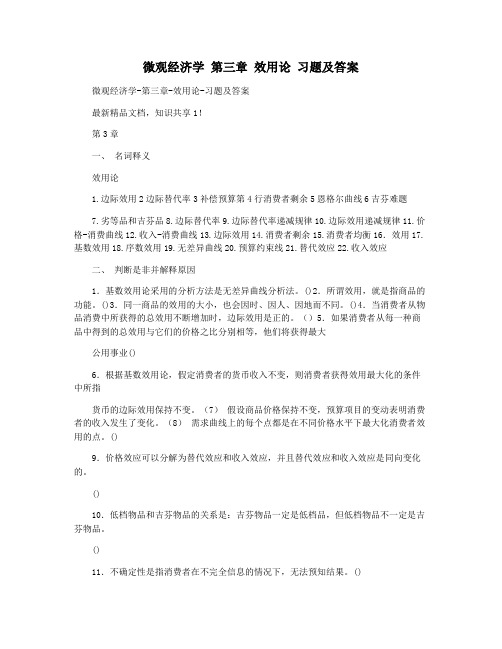
微观经济学第三章效用论习题及答案微观经济学-第三章-效用论-习题及答案最新精品文档,知识共享1!第3章一、名词释义效用论1.边际效用2边际替代率3补偿预算第4行消费者剩余5恩格尔曲线6吉芬难题7.劣等品和吉芬品8.边际替代率9.边际替代率递减规律10.边际效用递减规律11.价格-消费曲线12.收入-消费曲线13.边际效用14.消费者剩余15.消费者均衡16.效用17.基数效用18.序数效用19.无差异曲线20.预算约束线21.替代效应22.收入效应二、判断是非并解释原因1.基数效用论采用的分析方法是无差异曲线分析法。
()2.所谓效用,就是指商品的功能。
()3.同一商品的效用的大小,也会因时、因人、因地而不同。
()4.当消费者从物品消费中所获得的总效用不断增加时,边际效用是正的。
()5.如果消费者从每一种商品中得到的总效用与它们的价格之比分别相等,他们将获得最大公用事业()6.根据基数效用论,假定消费者的货币收入不变,则消费者获得效用最大化的条件中所指货币的边际效用保持不变。
(7)假设商品价格保持不变,预算项目的变动表明消费者的收入发生了变化。
(8)需求曲线上的每个点都是在不同价格水平下最大化消费者效用的点。
()9.价格效应可以分解为替代效应和收入效应,并且替代效应和收入效应是同向变化的。
()10.低档物品和吉芬物品的关系是:吉芬物品一定是低档品,但低档物品不一定是吉芬物品。
()11.不确定性是指消费者在不完全信息的情况下,无法预知结果。
()三、判断问题1.同样一种商品的效用将因人,因地,因时的不同而不同。
()2.假定其他条件不变,消费者从每单位商品中得到的效用,随着这种商品数量的增加而增加()3.只要总效用是正数,边际效用就不可能是负数()4.对于一个消费者来说,同一数量的商品不管在什么情况下都提供同样数量的效用()5.如果消费者从每一种商品中得到的总效用与它们的价格之比分别相等,他将获得最大利润()6.在均衡条件下,消费者购买商品所得到的总效用,一定等于他因支付货币所失去的货币的总效用()7.在均衡的条件下,消费者对每单位商品所支付的货币的效用,等于他所购买的商品的边际效用()8.两条无差异曲线的交点所表示的商品组合,对于同一个消费者来说具有不同的效用()最新精品文档,知识共享1!9.用商品x代替商品y的边际替代率等于3意味着,1单位商品x和3单位商品y具有同样的效用()10.在消费者的收入和商品的价格一定的条件下,预算线是一条确定的直线()11.当无差异曲线和预算线相交时,消费者从交点所表示的商品组合所得到的商品效用达到最大()12.假设其他条件不变,如果商品价格下跌,根据效用最大化原则,消费者会购买更多的商品。
微观经济学第三章消费者行为理论习题(供参考)
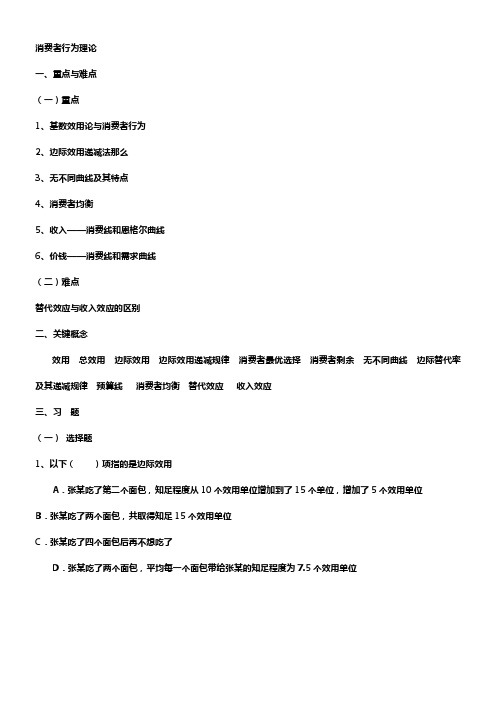
消费者行为理论一、重点与难点(一)重点1、基数效用论与消费者行为2、边际效用递减法那么3、无不同曲线及其特点4、消费者均衡5、收入——消费线和恩格尔曲线6、价钱——消费线和需求曲线(二)难点替代效应与收入效应的区别二、关键概念效用总效用边际效用边际效用递减规律消费者最优选择消费者剩余无不同曲线边际替代率及其递减规律预算线消费者均衡替代效应收入效应三、习题(一)选择题1、以下()项指的是边际效用A.张某吃了第二个面包,知足程度从10个效用单位增加到了15个单位,增加了5个效用单位B.张某吃了两个面包,共取得知足15个效用单位C.张某吃了四个面包后再不想吃了D.张某吃了两个面包,平均每一个面包带给张某的知足程度为7.5个效用单位E.以上都不对2、假设消费者张某只预备买两种商品X和Y,X的价钱为10,Y的价钱为2。
假设张某买了7个单位X和3个单位Y,所取得的边际效用值别离为30个单位和20个单位,那么()。
A.张某取得了最大效用B.张某应当增加X的购买,减少Y的购买C.张某应当增加Y的购买,减少X的购买D.张某想要取得最大效用,需要借钱E.无法确信张某该如何办3、假设X的价钱转变,X的替代效应小于收入效应,那么X是()A.正常品或低档品B.低档品C.正常品或吉芬商品D.必需品E.无法确信4、无不同曲线的形状取决于()A、消费者偏好B、消费者收入C、所购商品的价钱D、商品效用水平的大小5、一个消费者宣称,他早饭每吃一根油条要喝一杯豆浆,若是给他的油条数多于豆浆杯数,他将把多余的油条扔掉,若是给他的豆浆杯数多于油条数,他将一样处置. ()A.他关于这两种食物无不同曲线是一条直线B.他的偏好破坏了传递性的假定C.他的无不同曲线是直角的D 他的无不同曲线破坏了传递性的假定,因为它们相交了6、同一条无不同曲线上的不同点表示()。
A.效用水平不同,但所消费的两种商品组合比例相同B.效用水平相同,但所消费的两种商品的组合比例不同C.效用水平不同,两种商品的组合比例也不相同D.效用水平相同,两种商品的组合比例也相同7、对一名消费者来讲古典音乐磁带对流行音乐磁带的边际替代率是1/3,若是()A.古典音乐磁带的价钱是流行音乐磁带价钱的3倍,他能够取得最大的效用B.古典音乐磁带的价钱与流行音乐磁带价钱相等,他能够取得最大的效用C.古典音乐磁带的价钱是流行音乐磁带价钱的1/3,他能够取得最大的效用D.他用3盘流行音乐磁带互换一盘古典音乐磁带,他能够取得最大的效用E. 以上各项均不准确8、预算线的位置和斜率取决于()。
- 1、下载文档前请自行甄别文档内容的完整性,平台不提供额外的编辑、内容补充、找答案等附加服务。
- 2、"仅部分预览"的文档,不可在线预览部分如存在完整性等问题,可反馈申请退款(可完整预览的文档不适用该条件!)。
- 3、如文档侵犯您的权益,请联系客服反馈,我们会尽快为您处理(人工客服工作时间:9:00-18:30)。
Central University of Finance and Economics
School of Economics
Intermediate Microeconomics, Spring 2011
Homework 3
(Due Date: Friday, April 1, 2011)
1. (25 points)
A worker is considering how many hours to work, how many hours to enjoy life and how many dollars to consume. Let h represent the number of hours he works, l ( the lowercase of L) represent the hours of leisure, and c represent his consumption of
stuff in dollars. His preferences are represented by the utility function U=l*c. He has 24 hours in a day that he can allocate to working or leisure. Let w denote the hourly wage.
a. Given that he only has 24 hours in a day, how are l and c related? Given w , how are c and h related?
b. If w is equal to 1 ( the number), what are the combinations of leisure and consumption that he can achieve? Find the formula for his budget line. Graph the budget line in the graph (leisure in the horizontal axis).
c. Calculate the optimal choice? Draw his optimal choice in the previous graph. How many hours will he work?
d. Assume that now the wage decrease to 1/2, Write down the equation for her budget line and graph it.
e. Calculate the optimal choice? Draw his optimal choice in the previous graph. How many hours will he work?
f. How did his supply of labor change? What does this tell us about the magnitudes of the income and substitution effects from the change in wages?
2. (25 points)
A consumer is considering how much money to allocate to consumption when young and to consumption when old. Let c11represent her consumption in dollars when young, and let c2 represent her consumption in dollars when old. The consumer preferences are represented by the utility function U =c1c2. She earns 100 dollars when young and 100 dollars when old. Assume that the interest rate is 25% and that there is no inflation. She can either saver or borrow at the market interest rate and must pay back loans with interest.
a. What is the present value of the income flow for the person? What is the future value of the income flow for the person?
b. Write down the equation for her budget constraint and graph it.
c. Calculate the consumer’s optimal consumption bundle? Does she save or borrow? How much? Draw the optimal consumption bundle in the graph in point c.
d. Assume that now the interest rate increases to 100%. Write down the equation for her budget constraint and graph it. Be sure to graph the point where she neither saves nor borrow.
e. Calculate the consumer’s optimal consumption bundle? Do savings increase? How much? Draw the optimal consumption bundle in the graph in point d.
3. (20 points)
Suppose a consumer has a demand function of the form:
211(,,,)1()420400x y z x z x
m x p p p m m p p p =+++ Suppose that while the price of good x decreases from 4 to 2, income and other prices remain constant at m=100, p y =3 and p z =2 Find the change in quantity demanded. Find the magnitudes of the Slutsky substitution effect and income effect.
4. (30 points)
Dave is deciding how much to work in the coming year. He derives utility from consumption, C, but he also really likes taking leisure time L. He must divide his available hours between work and leisure for every hour of leisure he takes he must work one fewer hours. The function that describes his preferences is given by:
3
144(,)U C L C L = He can earn a wage of w, and suppose the price of consumption is given by p=1. Finally, Dave receives some non-wage income, m, which does not depend on the number of hours he works.
a. What is Dave’s full income if he can work 2000 hours in a year? Write down his budget constraint.
b. Solve Dave’s utility maximization problem and write down his optimal consumption of C and L. How does Dave’s consumption depend on w and m? Is leisure a normal good?
c. Suppose Dave’s wages are initially given by w = 10 and his non-labor income by m=100. Find his optimal levels of leisure and consumption. If Dave’s wage increases to w = 20, what are his new levels of leisure and consumption?
d. Graphically depict the income and substitution effects on leisure hours associated with the change in wage from 10 to 20. Do the income and substitution effects have the same sign? What is the intuition for this?。
